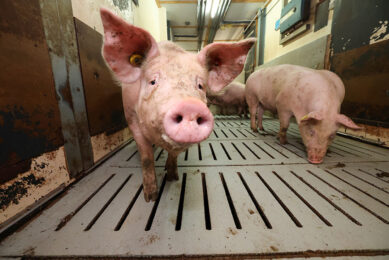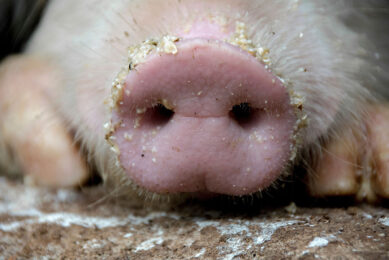ARS: Chatter of foodborne pathogens examined
Agricultural Research Service (ARS) scientists are finding ways to protect livestock and human health by quelling the cellular chatter of a common foodborne pathogen.
The complex cellular signaling and communication that takes place between bacteria and host is called “crosstalk.” ARS microbiologists Brad Bearson and Shawn Bearson are learning how to interpret the crosstalk between domestic swine and Salmonella enterica serovar Typhimurium (S. Typhimurium), which can cause gastrointestinal illness in livestock and humans.©
Brad Bearson works at the National Soil Tilth Laboratory in Ames, Iowa, and Shawn Bearson works at the ARS National Animal Disease Center, also in Ames.
The researchers studied how S. Typhimurium responds when it is exposed to norepinephrine, a hormonal neurotransmitter.©In mammals, norepinephrine secretion increases when stress levels increase-a situation swine commonly face during transport.©
The work revealed that S. Typhimurium is able to respond to norepinephrine by increasing bacterial movement (motility).©The scientists also found that phentolamine, a compound already used medicinally in humans, eliminated the pathogen’s norepinephrine-enhanced motility.
In E. coli, a protein called “QseC” is involved in the bacterial response to norepinephrine by enhancing the bacterium’s motility and virulence.©So the team developed a strain of S. Typhimurium with a genetic mutation that inactivated the QseC protein, and found that motility levels were lower in the mutant S. Typhimurium strain than in the wild-type strain.©
Furthermore, swine inoculated with this mutant strain had significantly decreased levels of S. Typhimurium colonization in their gastrointestinal tracts.©They also shed notably fewer pathogens-a finding with potential implications for food safety, since even asymptomatic pigs can carry and shed S. Typhimurium that can then infect other swine nearby.©
The researchers also identified key S. Typhimurium genes involved in the pathogen’s ability to acquire iron from norepinephrine within the host environment to support its own growth.
The research was published in the scientific journals Microbial Pathogenesis and Microbes and Infection.
Read more about this research in the August 2009 issue of Agricultural Research magazine, available online at: http://www.ars.usda.gov/is/AR/archive/aug09/swine0809.htm.
©
Join 18,000+ subscribers
Subscribe to our newsletter to stay updated about all the need-to-know content in the pigsector, three times a week. Beheer
Beheer










 WP Admin
WP Admin  Bewerk bericht
Bewerk bericht